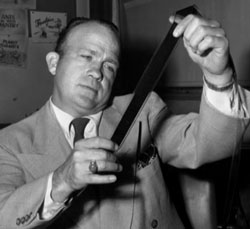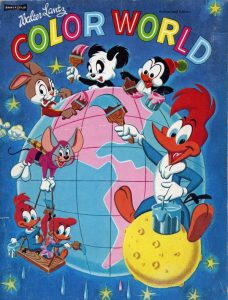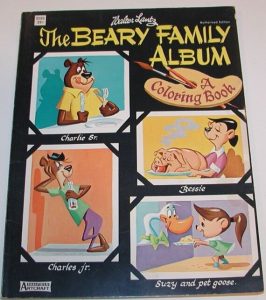
Jack Hannah
Suspended Animation #331
Jack Hannah was the first Disney animator I ever met and the first animator I ever interviewed. I interviewed him several times over the years starting in 1977. While he is best known for his work at Disney, he worked for two years at Walter Lantz from the end of 1959 to the end of 1962.
For Lantz, Hannah created several new characters including Gabby Gator, Fatso the Bear, Willoughby, the Beary Family, Sam and Simian as well as directing many of the Lantz superstars like Woody Woodpecker and Chilly Willy.
Here are some excerpts from one of my interviews with Jack:
Jack Hannah: Gerry Geronimi, who was a longtime friend of Walter Lantz’s and who I had worked with at Disney, talked to me when Disney let me go. He had gotten wind of my predicament and told Walter. One of their top directors, Alex Lovy, was leaving to work at Hanna-Barbera and they needed someone to fill in the slot.
I had never met Lantz before 1959, but he gave me a call and he and Bill Garity, who was Walter’s right-hand man at the time took me to lunch at the Lakeside Country Club and invited me to join them.
Lantz made me an offer that I would be his supervising director. Walter wanted to do more traveling, so I would help run the production end of the studio from the creative side, and Garity would be running the business end, when Walter was on his vacation trips.
Walter told me that he was very short on stories and wanted me to bring my first story with me when I came over to start work. I got Milt Banta to work with me on the story. Walter paid his writing fee. I brought Walter the story and he accepted it right away. I always thought that that was very clever that from the moment I walked in as a director I had my first story all ready to go. It was called Freeloading Feline.
When I left Disney, they were breaking up my whole unit. I took Riley Thompson with me as my layout man when I went to Lantz’s. I also took Ray Huffine and Al Coe. Even after I left Lantz later, the people I brought over with me stayed on.
At the Disney Studio you had storymen, a layout man, a background man, and you had all these different departments. But at Lantz, the director practically did everything himself in the laying out of the picture for animation. You did a rough layout, anyway. Paul Smith worked that way. I changed that somewhat when I brought over Ray Huffine.
 Lantz didn’t have hired storymen on staff. The directors usually had some background in story and had a lot of input into each cartoon. Walter would contract men from outside the studio to come in and do the stories. Then we’d have a meeting with these storymen telling the story and the director and Walter would sit in on these meetings. Naturally Walter would add little gags here and there. He was a pretty good gag man.
Lantz didn’t have hired storymen on staff. The directors usually had some background in story and had a lot of input into each cartoon. Walter would contract men from outside the studio to come in and do the stories. Then we’d have a meeting with these storymen telling the story and the director and Walter would sit in on these meetings. Naturally Walter would add little gags here and there. He was a pretty good gag man.
He was a gag man back in the old days when the philosophy of animation was “gag for gag’s sake” more than personality type gags, which Disney was more interested in doing. As long as your animation was entertaining, Walter would overlook minor flaws in the story because of budget.
Walter was very supportive, especially when I was directing him in the live-action segments for his television show. I had done several shorts for Walter and he wanted to do a television series with him introducing the cartoons like Disney did on his show.
Walt Disney had had me join the Director’s Guild so that I could direct the live-action segments on his weekly Disneyland television show on ABC. Lantz knew that I belonged to the Director’s Guild and that I had experience directing so I was the natural choice.
Unlike Disney, Walter took direction almost too well. He was pleased with any new ideas I suggested, and wasn’t afraid to try them. As a result, I think he came off looking really good in these introductions. He had a free and easy attitude. He wasn’t self-conscious.
Woody Woodpecker was well-designed and simple, so there was no problem in working with him. Gracie, who was Walter’s wife and at that time was doing the voice of Woody, knew the character inside and out, backwards and forwards and she was very easy to direct doing the vocals.
I did a cartoon with a couple of chimpanzees named Sam and Simian, a take-off on the name of the famous San Simeon castle where Hearst lived. We made one short with them, Jungle Medics (1961) where they were inept doctors trying to help a lion with his sore tooth.
The idea was to have them similar to Chip’n’Dale in that one was a smart guy who was always getting upset over the dumb guy’s antics. Walter was looking to sell another TV series and this was one of the things we did. He later ran it as a theatrical short and then put it into the television syndication package.
Another series I developed for Walter to try to sell as a TV series was The Beary Family. The name was a take-off on actor Wallace Beery, who was very popular and seems to have inspired a lot of cartoon bears over the years. We had a father, mother, and a stupid son and cute little daughter with a ponytail. It was like a typical TV sitcom but with bears.
 I think Walter was looking at the success that Hanna-Barbera was having at the time and wanted to see if his studio could do something similar.
I think Walter was looking at the success that Hanna-Barbera was having at the time and wanted to see if his studio could do something similar.
Walter gave me a lot of freedom as long as I stayed within budget. That is how his cartoon studio lasted so long when all the other studios had to close. Disney had stopped making theatrical shorts because they were getting much too expensive.
Unless he was on a trip, he was around quite a bit. He was the boss, so sometimes he’d come in an hour later than the rest of us. I think Walter knew he didn’t have the time nor material to get into a full-length animated feature. That would have been quite a risk financially. I don’t even recall him mentioning he was even interested in doing a feature, at least while I was there.
I left Lantz on good terms. I felt I just needed to move on. The only trouble is, once you’ve been at Disney’s, everything else at another animation studio was just a job. No extra effort was needed and the people you were working with were just not at that level that was at Disney’s. And as a result, I just got bored there. I always gave Walter my best and he was terrific to me but I wasn’t feeling challenged and I wasn’t having any fun.


 Jim Korkis is an internationally respected animation historian who in recent years has devoted his attention to the many worlds of Disney. He was a columnist for a variety of animation magazines. With his former writing partner, John Cawley, he authored several animation related books including The Encyclopedia of Cartoon Superstars, How to Create Animation, Cartoon Confidential and Get Animated’s Animation Art Buyer’s Guide. He taught animation classes at the Disney Institute in Florida as well as instructing classes on acting and animation history for Disney Feature Animation: Florida.
Jim Korkis is an internationally respected animation historian who in recent years has devoted his attention to the many worlds of Disney. He was a columnist for a variety of animation magazines. With his former writing partner, John Cawley, he authored several animation related books including The Encyclopedia of Cartoon Superstars, How to Create Animation, Cartoon Confidential and Get Animated’s Animation Art Buyer’s Guide. He taught animation classes at the Disney Institute in Florida as well as instructing classes on acting and animation history for Disney Feature Animation: Florida.




















































I’m reminded of the first time I went backstage after a concert, when I was fifteen, and met a pianist named Andre Watts. He was very friendly, and in the following years I met many other concert artists, some of whom were friendlier than others. But I wouldn’t have met any of them if Watts hadn’t been such a nice guy. So I’m guessing that your initial encounter with Jack Hannah was likewise very positive, and laid the foundation for all the subsequent animator interviews you conducted.
“Freeloading Feline” is quite a good cartoon, with an unexpected shift in dynamic when the punchy boxer’s suggestiveness transforms him from ally to adversary in an instant. It shows the level of quality that Hannah, with his long experience at Disney, was able to bring to the Lantz studio. “Sam ‘n’ Simian” suffers in comparison; the setups of the gags take forever, and the payoffs are weak. The lack of dedicated story men at the Lantz studio was a major drawback by this point.
Walter Lantz always came across as a warm, likeable figure in the live-action segment on his show. But then, so did Walt Disney. It’s interesting that Hannah’s direction helped bring out these qualities in both men on their respective shows.
You are correct sir. I met Hannah when I was a late teen and saw his name in a local newspaper article that mentioned he had worked at Disney. At the time, he was teaching at CalArts. He was indeed warm and generous with his time. An interview that was supposed to take one hour for my school newspaper ended up lasting three hours and at the end of it, he called up two other animators who lived in Glendale like he did and told them they should talk to me.
Hannah before Disney had been a Golden Gloves boxer which might be why you liked the boxer in Freeloading Feline.
In all my years of knowing Hannah, he was indeed likeable and patient. One of the reasons he left Disney other than Disney shutting down the shorts department and Walt’s reluctance to move him into animated features or live action features despite his demonstrated talent in those areas was a drinking problem. He loved teaching at CalArts and many of the future Pixar legends were in his class.
Hannah directed live-action Lantz on the Woody Woodpecker Show.
Hannah was hired to replace Alex Lovy in 1959.
The Woody Woodpecker Show debuted in 1957.
Who directed Lantz the first two years? He had to be on in 1957 because Lovy is in some of the clips.
Some chronological background: the Lantz payroll records (noted by Joe Adamson) indicate that Hannah was at Lantz from June 1, 1959 to December 29, 1961.
Due to the success of Disney’s SNOW WHITE, and the announcement of the production of Fleischer’s GULLIVER’S TRAVELS in 1939, there was a publicity announcement that Lantz and Universal were planning an animated feature of ALADDIN AND HIS WONDERFUL LAMP. But the project was cancelled, not because of the Popeye two-reel Special of the same name, but because Lantz considered the financial risks. Apparently he might have heard about what Fleischer was going through with Paramount, particularly the escalating costs, and bowed out of the deal. But Lantz was at his zenith at this time, and “chances” are that a Lantz feature might have been financially successful. But, Lantz did manage to keep his studio, which continued to produce theatrical cartoons long after the other established studios, including Fleischer had closed.
Despite his decision not to make features, Lantz did take a couple of pages from Disney’s book.
One, those filmed bits on “The Woody Woodpecker Show”. He certainly wasn’t as slick as Uncle Walt had become, but as Hannah says he was un-self conscious and that came across. He was like somebody’s amiable dad in a home movie. In fact, all the Lantz crew in those bits register as boomer kids’ dads, puttering around in casual clothes.
Two, he kept ownership of his films and characters. His cartoons were on television only via his own show, making them kind of a big deal to kids (this one, anyway) used to everybody else’s cartoons (save Disney’s) saturating local airwaves in syndication.